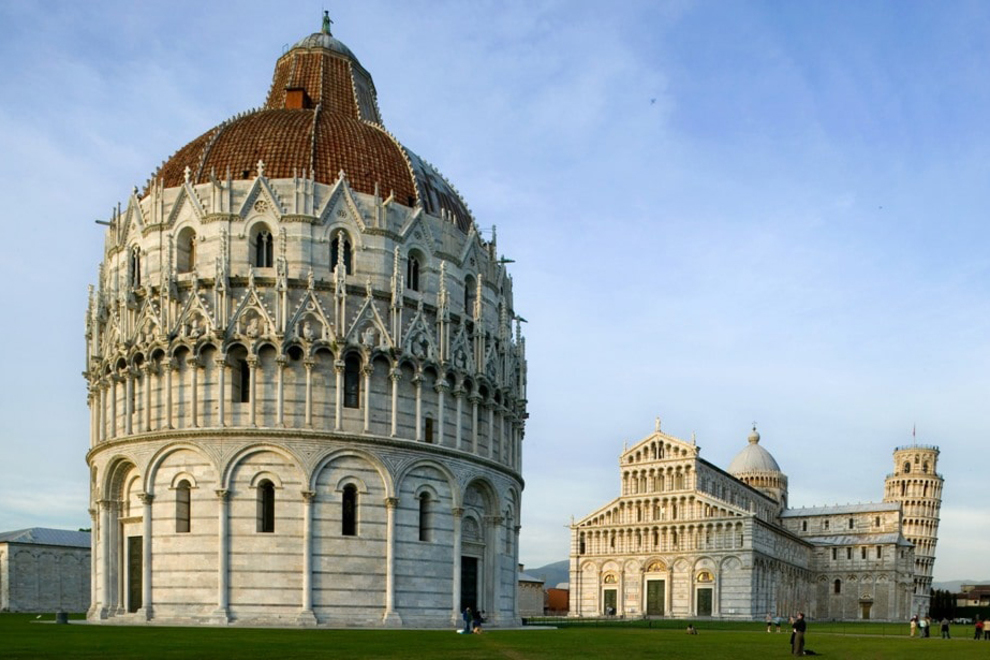
Pisa, a city of art and monuments surrounded with gentle hills and luxury properties
The monuments in Piazza del Duomo, UNESCO World Heritage Site which the world envies
The Piazza del Duomo in Pisa, also called Piazza dei Miracoli by the people, is so rich in one-of-a-kind art and history that it was classified as a World Heritage Site by UNESCO. The Romanesque-style monuments in this square attract over four million tourists each year. Broker Immobiliare Exclusive Real Estate lists luxury estates, farmhouses, and villas for sale in the hills of Pisa, a few kilometers from this Tuscan epicenter of history and art.
Romanesque architecture spread across Europe in the 11th and 12th centuries. As Gothic architecture started to take hold in the mid 1100s, Gothic elements in Romanesque buildings are not uncommon. Pisan Romanesque developed of course is Pisa and characterizes the buildings in the famous Piazza dei Miracoli. The main architectural characteristics of Pisan Romanesque are marble or granite columns, great arches and apses, and Corinthian capitals, which evoke Roman and Byzantine architecture, as well as the early Roman basilicas.
The Piazza del Duomo, also known as Piazza dei Miracoli was classified as a UNESCO World Heritage Site in 1987. The name Piazza dei Miracoli is due to the four monuments in the piazza, which were called “miracoli” (miracles) by Italian poet and intellectual Gabriele D’Annunzio: the Duomo of Santa Maria Assunta, the Baptistery of St. John, the leaning Tower, and the Camposanto Monumentale (monumental cemetery).
The Dome was opened by Pope Gelasio II in 1064 and lays without the city wall, a choice of location that symbolizes the city’s might: a powerful maritime city fearing nothing. The Duomo has a Latin cross plan with five aisles, the centrale nave being covered with a coffered wooden ceiling. The naves are flanked by overall sixty columns made of granite from Elba Island. The outer walls area adorned with bronze details and mosaics. The marble inside is black and white, and there are mosaics from the 1300s and frescoes from the 1500s and 1600s. The octagonal-shaped St. Andrew’s pulpit was sculpted by Giovanni Pisano and represents scenes from the New Testament, in a style forerunning Gothic style. As the Dome’s structure is slanted upwards, it evokes the structure of Gothic cathedrals.
St. John’s Baptistery is in front of the Dome’s western façade and south of the Campo Santo. Not only is it the biggest baptistery in Italy, but also in the whole world, having a 2m-63cm diameter and being 54m-86cm high. Scenes from the life of Christ are sculpted in the marble pulpit: the Annunciation, the Adoration of the Magi, Christ’s Presentation at the Temple, the Crucifixion, and the Last Judgement. The pulpit also has a peculiar shape: it is hexagonally shaped, whereas all the ones sculped until then were square or rectangular. Inside the Baptistery, you can experience a peculiar acoustic effect: thanks to the shape of the building and the arrangement of indoor areas, a peculiar echo travels through the atmosphere as continuous wave with an ascending tonality, thus resembling an angelic choir.
On the north side of Piazza del Duomo is the Campo Santo, the historic monumental cemetery of Pisa, also known as the monumental Camposanto or the old Camposanto. Prominent military and political burials of the eleventh, twelfth, and thirteenth centuries lay in large marble sarcophagi. The exterior is in white marble with 43 arches, and the interior is decorated with frescoes, the most famous of which represent scenes from Dante's Divine Comedy, such as the Last Judgment. The best-known fresco inside the Camposanto is The Triumph of Death, commissioned by Dominican friars and painted by Buonamico Buffalmacco. The Camposanto was severely damaged in 1944 during WWII bombings. Of the damaged frescoes the sinopias remained, that is the preparatory drawings in red earth, which are today an unparalleled historical and artistic trace. They are housed in the Museo delle Sinopie.
But the real piece de resistance in Piazza del Duomo is the leaning Tower, a truly unique building. Already during the early stages of construction, the ground below the base gave way, causing the slope of the building. The ground is indeed soft clay, and the other buildings in the Piazza are also slightly leaning, although not as visibly as the famous Tower. Construction work began in 1173, then temporarily stopped at the third-floor stage due to the weakness of the underlying soil. It then resumed under Giovanni Pisano and Vanni di Simone in 1275. In the 1990s the leaning of the monument had to be reduced by adding some lead counterweights along part of the base’s circumference.
The gentle slopes of the hills of Pisa are few tens of kilometers from the city of Pisa. There are vast and verdant olive groves where excellent oil and wine are locally produced. There are many trails with food and wine tastings, such as the Strada del Vino, as well as Etruscan ruins and lavender fields. Buying a luxury property on the Pisan hills, a few kilometers from the city of Pisa, through the professional services of Broker Immobiliare Exclusive Real Estate, will give you the chance to live in one of the most renowned Tuscan wine-making areas while also being able to easily visit one of the most important historical places in the world.
